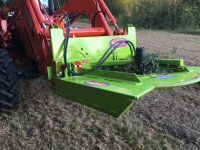Complete Turf Care
Veteran Member
- Joined
- Mar 31, 2013
- Messages
- 1,920
- Location
- South Louisiana
- Tractor
- 2022 Kubota Grand L6060 (no loader), 2017 Kubota Grand L6060, 2011 Kubota L5740 HSTC-3, 1997 Kubota M4700
12.1 GPM, uses one rear remote supplied with the lever in the Forward position and the return is “T” back in to the return coming from the loader functions just below the floorboard.
Could you post pics of how you added the 'T'? I had a similar issue with my laser leveling blade on my Kubota L5740. I had a welder build the fitting shown in the pics below. I could not find a place on the Kubota to put a 'T'. And several Kubota mechanics could not help me.
![IMG_3706[1].jpg IMG_3706[1].jpg](https://www.tractorbynet.com/forums/data/attachments/334/334958-da7da700b227dd23c511c8cdda81eaa6.jpg)
![IMG_3707[1].jpg IMG_3707[1].jpg](https://www.tractorbynet.com/forums/data/attachments/334/334984-df0a0895ca8d0d65b6830d5beaa371b9.jpg)


